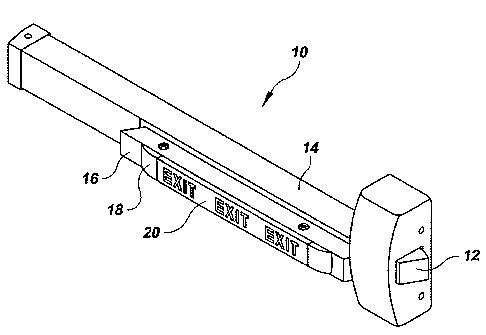Some of the information on this Web page has been provided by external sources. The Government of Canada is not responsible for the accuracy, reliability or currency of the information supplied by external sources. Users wishing to rely upon this information should consult directly with the source of the information. Content provided by external sources is not subject to official languages, privacy and accessibility requirements.
Any discrepancies in the text and image of the Claims and Abstract are due to differing posting times. Text of the Claims and Abstract are posted:
| (12) Patent: | (11) CA 2551108 |
|---|---|
| (54) English Title: | EXIT DEVICE WITH LIGHTED TOUCHPAD |
| (54) French Title: | DISPOSITIF DE SORTIE COMPRENANT UNE TOUCHE A EFFLEUREMENT ECLAIREE |
| Status: | Granted and Issued |
| (51) International Patent Classification (IPC): |
|
|---|---|
| (72) Inventors : |
|
| (73) Owners : |
|
| (71) Applicants : |
|
| (74) Agent: | SMART & BIGGAR LP |
| (74) Associate agent: | |
| (45) Issued: | 2010-11-23 |
| (86) PCT Filing Date: | 2004-12-08 |
| (87) Open to Public Inspection: | 2005-07-21 |
| Examination requested: | 2007-11-29 |
| Availability of licence: | N/A |
| Dedicated to the Public: | N/A |
| (25) Language of filing: | English |
| Patent Cooperation Treaty (PCT): | Yes |
|---|---|
| (86) PCT Filing Number: | PCT/US2004/040987 |
| (87) International Publication Number: | US2004040987 |
| (85) National Entry: | 2006-06-21 |
| (30) Application Priority Data: | ||||||
|---|---|---|---|---|---|---|
|
An exit device includes an electroluminescent exit sign assembly, preferably
mounted on a push rail actuator of the exit device. An electroluminescent
illuminator, an opaque material and a transparent protective cover form the
electroluminescent sign assembly. The push rail actuator operates a latch
mechanism and opens an associated exit door when pressure is applied. An
inverter may be located within the exit device to power the electroluminescent
illuminator with an AC or voltage. The electroluminescent sign assembly is
preferably removable for repair or replacement without removing the exit
device from the exit door and is located within a surface cavity in an
electrically insulating touchpad on the exit device actuator. Additional
transparent nonconductive material surrounds the electroluminescent material
to provide further electrical insulation.
L'invention concerne un dispositif de sortie comprenant un ensemble de signe de sortie électroluminescent, de préférence monté sur une commande à rail poussoir du dispositif de sortie. Un illuminateur électroluminescent, un matériau opaque et un élément couvrant protecteur transparent constituent l'ensemble de signe électroluminescent. La commande à rail poussoir fait fonctionner un mécanisme de verrouillage et ouvre une porte de sortie associée quand de la pression est appliquée. Un inverseur peut être placé dans le dispositif de sortie, de manière à alimenter l'illuminateur électroluminescent au moyen de CA ou de tension. L'ensemble de signe électroluminescent est, de préférence, amovible aux fins de réparation ou de remplacement, sans retrait du dispositif de sortie de la porte de sortie, et il est situé dans une cavité de surface dans une touche à effleurement électriquement isolante sur la commande du dispositif de sortie. Un matériau non conducteur transparent supplémentaire entoure le matériau électroluminescent, de manière à conférer une isolation électrique supplémentaire.
Note: Claims are shown in the official language in which they were submitted.
Note: Descriptions are shown in the official language in which they were submitted.

2024-08-01:As part of the Next Generation Patents (NGP) transition, the Canadian Patents Database (CPD) now contains a more detailed Event History, which replicates the Event Log of our new back-office solution.
Please note that "Inactive:" events refers to events no longer in use in our new back-office solution.
For a clearer understanding of the status of the application/patent presented on this page, the site Disclaimer , as well as the definitions for Patent , Event History , Maintenance Fee and Payment History should be consulted.
| Description | Date |
|---|---|
| Common Representative Appointed | 2019-10-30 |
| Common Representative Appointed | 2019-10-30 |
| Change of Address or Method of Correspondence Request Received | 2018-01-12 |
| Grant by Issuance | 2010-11-23 |
| Inactive: Cover page published | 2010-11-22 |
| Inactive: Final fee received | 2010-09-03 |
| Pre-grant | 2010-09-03 |
| Notice of Allowance is Issued | 2010-06-16 |
| Letter Sent | 2010-06-16 |
| Notice of Allowance is Issued | 2010-06-16 |
| Inactive: Approved for allowance (AFA) | 2010-06-01 |
| Amendment Received - Voluntary Amendment | 2009-12-23 |
| Inactive: S.30(2) Rules - Examiner requisition | 2009-06-25 |
| Letter Sent | 2008-02-08 |
| Inactive: IPRP received | 2008-02-06 |
| Request for Examination Requirements Determined Compliant | 2007-11-29 |
| All Requirements for Examination Determined Compliant | 2007-11-29 |
| Request for Examination Received | 2007-11-29 |
| Inactive: Cover page published | 2006-09-06 |
| Inactive: Notice - National entry - No RFE | 2006-08-30 |
| Letter Sent | 2006-08-30 |
| Application Received - PCT | 2006-07-31 |
| National Entry Requirements Determined Compliant | 2006-06-21 |
| Application Published (Open to Public Inspection) | 2005-07-21 |
There is no abandonment history.
The last payment was received on 2010-10-04
Note : If the full payment has not been received on or before the date indicated, a further fee may be required which may be one of the following
Patent fees are adjusted on the 1st of January every year. The amounts above are the current amounts if received by December 31 of the current year.
Please refer to the CIPO
Patent Fees
web page to see all current fee amounts.
Note: Records showing the ownership history in alphabetical order.
| Current Owners on Record |
|---|
| SARGENT MANUFACTURING COMPANY |
| Past Owners on Record |
|---|
| DANIEL J. PICARD |
| THANASIS MOLOKOTOS |